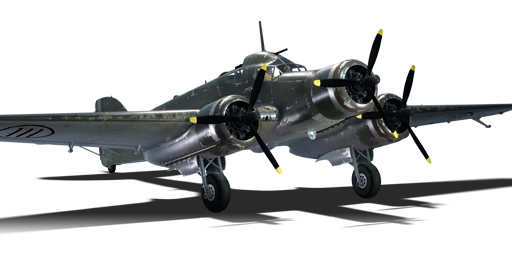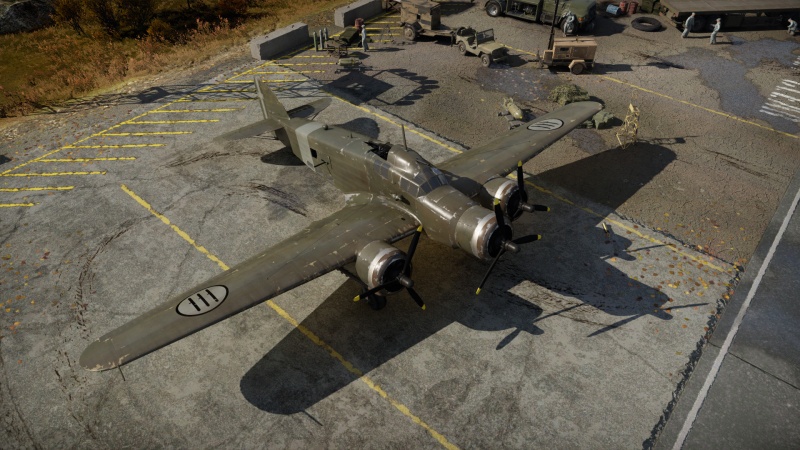S.M.79 bis/T.M
| This page is about the Italian bomber S.M.79 bis/T.M. For other versions, see S.M.79 (Family). |
Contents
Description
The S.M.79 Sparviero bis/T.M (1943) is a rank Italian bomber with a battle rating of (AB), (RB), and (SB). It was introduced in Update 1.69 "Regia Aeronautica" along with the initial Italian aircraft tree.
General info
Flight performance
| Characteristics | Max Speed (km/h at 4,000 m) |
Max altitude (metres) |
Turn time (seconds) |
Rate of climb (metres/second) |
Take-off run (metres) | |||
|---|---|---|---|---|---|---|---|---|
| AB | RB | AB | RB | AB | RB | |||
| Stock | 411 | 395 | 32.6 | 33.3 | 3.2 | 3.2 | 450 | |
| Upgraded | 457 | 430 | 30.7 | 31.6 | 9.3 | 5.9 | ||
Details
| Features | ||||
|---|---|---|---|---|
| Combat flaps | Take-off flaps | Landing flaps | Air brakes | Arrestor gear |
| ✓ | ✓ | ✓ | X | X |
| Limits | ||||||
|---|---|---|---|---|---|---|
| Wings (km/h) | Gear (km/h) | Flaps (km/h) | Max Static G | |||
| Combat | Take-off | Landing | + | - | ||
| 313 | 298 | 220 | ~4 | ~2 | ||
| Optimal velocities (km/h) | |||
|---|---|---|---|
| Ailerons | Rudder | Elevators | Radiator |
| < 260 | < 270 | < 270 | > 310 |
Survivability and armour
- 12 mm steel - behind pilots
- 6 mm steel - sides of pilots
- 9 mm steel - behind dorsal gunner
- 6 mm steel - right side of dorsal gunner
- 6 mm steel - in front of lateral gunners
Modifications and economy
Armaments
Offensive armament
The S.M.79 bis/T.M is armed with:
- 1 x 12.7 mm Breda-SAFAT machine gun, forehead-mounted (350 rpg)
Suspended armament
The S.M.79 bis/T.M can be outfitted with the following ordnance:
- 12 x 50 kg GP 50 bombs (600 kg total)
- 12 x 100 kg GP 100 bombs (1,200 kg total)
- 5 x 250 kg GP 250 bombs (1,250 kg total)
- 1 x 450 mm F200/450 torpedo
- 2 x 500 kg GP 500 bombs (1,000 kg total)
Defensive armament
The S.M.79 bis/T.M is defended by:
- 1 x 12.7 mm Breda-SAFAT machine gun, dorsal turret (500 rpg)
- 1 x 12.7 mm Breda-SAFAT machine gun, 2 x beam turrets (350 rpg)
Usage in battles
RB/SB mode
Air mode
The S.M.79 bis/T.M is a mediocre bomber at its battle rating in air battles. At the beginning of the battle, go up to 3,000-4,500 m and go to destroy enemy bases. Whenever enemy fighters or other aircraft attack the S.M.79 bis/T.M, use your gunners to fight back against enemy aircraft, it is recommended to use the universal ammunition for the 12.7 mm Breda-SAFAT turret belt because it contains 2 API-T and 2 AP-I per belt. AP-I and API-T ammo is perfect for defeating enemy planes because it can knock out the enemy pilot or set fire to enemy planes. When you are close to the enemy base, use your bomber sights to drop your bombs and then return to the airfield to reload your bombs.
'Ground mode
You can use the S.M.79 bis/T.M in ground battles with the following payloads: 5 x 250 kg (Mod.28) or 2 x 500 kg (Type 28). After spawning with the S.M.79 bis/T.M, stay at an altitude of 900-1,500 m and use the bomber crosshairs to drop the bombs more accurately. The selected bombs in the payload are very good, so if your bombs get close to enemy medium and heavy tanks, they can be destroyed very easily.
Naval mode
The S.M.79 bis/T.M has in its arsenal the ability to equip the 450 mm torpedo (F200/450). The torpedo drop performance is mediocre so the S.M.79 bis/T.M has to be under 301 km/h and a height of less than 120 m to use it. However, the torpedo's effect against ships are very good due to the 200 kg of explosives in the warhead.
AB mode
Like any bomber in Arcade Battles, the S.M.79 bis/T.M is likely to be the first to be destroyed. Go up to 4,000-5,000 m and stay at that height and drop bombs onto enemy bases. Remember that the S.M.79 bis/T.M can be destroyed very easily by enemy planes, so be careful and maintain situational awareness to see if there are enemy planes coming.
Manual Engine Control
| MEC elements | ||||||
|---|---|---|---|---|---|---|
| Mixer | Pitch | Radiator | Supercharger | Turbocharger | ||
| Oil | Water | Type | ||||
| Not controllable | Controllable Not auto controlled |
Not controllable Not auto controlled |
Not controllable Not auto controlled |
Separate | Not controllable 1 gear |
Not controllable |
Pros and cons
Pros:
- All defensive machine guns are 12.7 mm Breda-SAFAT
- Pilot-controlled fixed forward-firing 12.7 mm Breda, which can be equipped with IAI (explosive) ammunition
- Middle engine provides some level of protection for the pilot against head-on attacks
- Decent armour protection
Cons:
- Very limited bomb payload
- Poor defensive fire arcs, especially vulnerable to attacks from behind and below
- No frontal defensive gun covering the frontal aspect
- Forced to choose between less total bomb payload, but individually more powerful bombs or higher total bomb payload with less powerful bombs
- Fewer defensive machine guns than other Sparvieros
- Worst speed and flight capabilities than the previous model
History
Alessandro Marchettí was famous for creating record breaking and Schneider Trophy winning racing seaplanes, and was the Savoia (aka SIAI, Società Idrovolanti Alta Italia). In 1922 Marchettí joined Savoia to form one of the great aircraft companies in history, until merged in 1983. After the conclusion of the Schneider Trophy race (won by UK), the firm used its experience to build fast aircraft for civilian and military use.
The very similar looking Italian SM.81 bomber in the game was a militarized version of the successful S.73. The SM.79 was new passenger version based on the platform of its predecessor; the most obvious difference was retractable landing gear. It was truly made first as a passenger version to compete with those being made by other countries. Needless to say, it immediately attracted attention of the Regina Italia and a bomber version was developed in parallel. For a few brief months it was considered the best transport and bomber in world and became a major point of pride in Fascist Italy and was sold to several countries in the years before WW2.
Unlike nearly every bomber in War Thunder (and even in WW2), it was built mainly of steel a wood! The fuselage was a common for time welded steel tube design, with entire rear half being covered in cloth and plywood. The crew area to nose was duralumin cladded (which is very similar to Hawker Hurricane's construction). Most surprising the wings are completely wood! A major technical achievement for its size. During its production life several engines where tried, depending on power and reliability, one model even removing the nose engine.
To make the SM.79 fast the wings are shorter than typical for its weight. To compensate for higher clean stall speed a number of advanced high lift devices were used to reduce stall speed for landing, being Handley-Page leading extending slats and drooping ailerons (also called “flaperons”) in conjunction with uncommon slotted flaps. After trying a few engines, the Alfa Romeo 126 was used on the prototypes for testing and the record breaking flights soon after. As with the SM.73 / S.81, once again the Italian military wanted a bomber version and laid out proposed additions.
Sparviero goes to war
The spacious cabin was easy to install a set of bomb racks, all bombs mounted vertically (not unusual for time). While the S.81 had the bomb aimers position just behind the nose-mounted engine, the SM.79 positioned it in a ventral “tub” well after of the bomb bay itself. Also unlike the S.81 this streamlined tub also became the location of the ventral defensive gun, usually a 12.7mm Breda-SAFT MG instead of a turret. A streamlined dorsal mount was also installed for a rear firing 12.7mm MG, and unusually for bombers a fixed, pilot fired forward mounted 12.7mm MG, firing above the propeller disk. Both these streamlined protrusions could be closed to greatly minimize drag for a very high cruise speed, which the turreted S.81 could not. It was the prominent hump on its top that earned the nickname il gobbo maledetto ("damned hunchback"). Italy was open to export sales, and many countries purchased this top of line bomber to add to their forces.
From the high of the Spanish Civil War to the end of WW2, the Sparviero was the backbone of Italian bomber air forces and continued to do well over the vast stretches of the Mediterranean sea despite better allied defenses. Success was made despite high losses up to the Italian Armistice. They continued to be used in lesser roles on both sides of the conflict, and after the war were used for various duties by several nations for years later. Lebanon was the last operator who used them well in the 1950s and are the last 2 remaining SM.79s in the world.
This version was dedicated toward low level anti-ship torpedo missions. To improve speed the unnecessary ventral tub was removed, as they flew too low to be attacked from below the aircraft. The ability to carry bombs was retained.
Media
- Skins
See also
- Related development
External links
| Savoia-Marchetti | |
|---|---|
| Bombers | S.M.79 serie 1 · S.M.79 serie 8 · S.M.79 AS · S.M.79 bis/T.M |
| S.81 | |
| Attackers | SM.91 · SM.92 |
| Export | S.M.79 B |
| Captured | ▀S.M.79 serie 1 · ▀S.M.79 serie 4 · ▀S.M.79 serie 8 |
| ▀S.M.79 AS · ▀S.M.79 bis/N · ▀S.M.79 bis/T.M · ▀S.M.79 B | |
| Italy bombers | |
|---|---|
| Fiat | B.R.20DR · B.R.20M M1 |
| Savoia-Marchetti | S.81 · S.M.79 serie 1 · S.M.79 B · S.M.79 serie 8 · S.M.79 AS · S.M.79 bis/T.M |
| CANT | Z.1007 bis serie 3 · Z.1007 bis serie 5 |
| Piaggio | P.108B serie 1 · P.108B serie 2 |
| Foreign: | |
| Germany | ▄Ju 87 R-2 · ▄Ju 87 D-3 |
| Hungary | ◔Tu-2S-59 |





